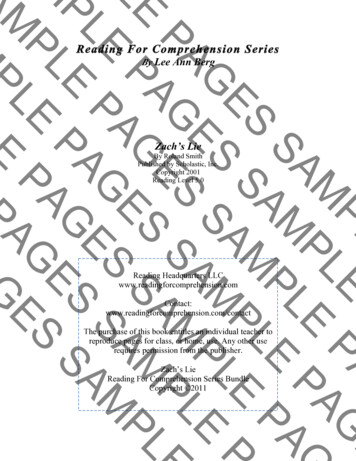
Transcription
SAUncorrected proof, all content subject to change at publisher discretion. Not for resale, circulation or distribution in whole or in part. Pearson 2018PEARSON EDEXCEL INTERNATIONAL A LEVELeBookinsideEMPLMATHEMATICSMECHANICS 1STUDENT BOOK
E4.4Learning objectivesMPLA er completing this chapter you should be able to: Resolve forces into components pages 91 96 Use the triangle law to find a resultant force pages 93 96 Solve problems involving smooth or rough inclinedplanes pages 96 99 Understand friction and the coefficient of friction. pages 100 103 Use F μR pages 100 103Prior knowledge check1A particle of mass 5 kg is acted on by two forces:F1 (8i 2j) N and F2 ( 3i 8j) N.Find the acceleration of the particle in the form( pi qj) m s 2.SAUncorrected proof, all content subject to change at publisher discretion. Not for resale, circulation or distribution in whole or in part. Pearson 20185 FORCES ANDFRICTION2 P2 Chapter 6In the diagram below, calculatea the length of the hypotenuseb the size of α.Give your answers correct to 2 d.p.7α15 International GCSE MathematicsA car’s braking distance isdetermined by its speed and thefrictional force between the car’swheels and the road. In wet or icyconditions, friction is reduced so thebraking distance is increased.
CHAPTER 5FORCES AND FRICTION5.1 Resolving forces If a force is applied at an angle to the direction of motion you can resolve it to find thecomponent of the force that acts in the direction of motion.This book is being dragged along the table by means of a force of magnitude F. The book is movinghorizontally, and the angle between the force and the direction of motion is θ.EFNθBDirectionof motionMPLAThe effect of the force in the direction of motion is the length of the line AB. This is called thecomponent of the force in the direction of motion. Using the rule for a right-angled triangleadjacent , you can see that the length of AB is F cos θ. Finding this value is calledcos θ hypotenuseresolving the force in the direction of motion. The component of a force of magnitude F in a certain direction is F cos θ, where θ is the size ofthe angle between the force and the direction.FNFNDD180 FNDIf F acts at the right anglesIf F acts in the directionIf F acts in the opposite directionto D, then the componentto D, then the component of F inD, then the component ofof F in that direction isF in that direction isthat direction isFcos90 F 0 0F cos 0 F 1 FF cos 180 F –1 –FExample1SAUncorrected proof, all content subject to change at publisher discretion. Not for resale, circulation or distribution in whole or in part. Pearson 201896Find the component of each force in i the x-direction ii the y-directioniii Hence write each force in the form pi qj where i and j are the unit vectors in the x and ydirections respectively.ayby9N40 xx18 100 N
CHAPTER 5iiθ 90 40 50 y9Nθ40 xGive your answers correct to threesignificant figures.Make sure you find the angle between theforce and the direction you are resolving in.You could also use F sin 40 assin 40 cos (90 40 ) cos 50 MPLComponent in y-direction F cos θ 9 cos 50 5.79 N (3 s.f.)97Ea i θ 40 Component in x-direction F cos θ 9 cos 40 6.89 N (3 s.f.)iii (6.89i 5.79j) Nθ 90 18 108 yb ixYou get a negative answer because youare resolving in the positive x-direction.You could also resolve in the negativex-direction using θ 90 18 72 ,then change the sign of your answer frompositive to negative:θy18 100 NComponent in x-direction F cos θ 100 cos 108 30.9 N (3 s.f.)iiySAUncorrected proof, all content subject to change at publisher discretion. Not for resale, circulation or distribution in whole or in part. Pearson 2018FORCES AND FRICTIONθθ 180 18 162 xθx18 100 NYou could use θ 18 then change the signof your answer from positive to negative: 100 cos 18 95.1 N (3 s.f.).18 100 NComponent in y-direction F cos θ 100 cos 162 95.1 N (3 s.f.)iii ( 30.9i 95.1j) NYou can measure θ in either the clockwise orthe anticlockwise direction sincecos θ cos(360 θ).
CHAPTER 5ExampleFORCES AND FRICTION2A box of mass 8 kg lies on a smooth horizontal floor.A force of 10 N is applied at an angle of 30º causing the boxto accelerate horizontally along the floor.10 N8 kga Work out the acceleration of the box.30 b Calculate the normal reaction between the box and the floor.Add the weight of the box and the normalreaction to the force diagram.MPL10 NResolve the force horizontally and write an equationof motion for the box. Year 1, Chapter 10Ea R( ), 10 cos 30 8a8a 5 3 5 3 2a m s8bR8 kgF sin θ30 FNθ8gR( ),R 10 sin 30 8gR 78.4 5 73 N (2 s.f.)F cos θThe component in the y-direction isF cos(90 θ) F sin θYou can use the triangle law of vector addition to find the resultant of two forces acting at an anglewithout resolving them into components.PExample3Two forces P and Q act on a particle as shown. P has a magnitudeof 10 N and Q has a magnitude of 8 N. Work out the magnitudeand direction of the resultant force.SAUncorrected proof, all content subject to change at publisher discretion. Not for resale, circulation or distribution in whole or in part. Pearson 201898R30 8Nθ10 N105 45 30 QUse the triangle lawfor vector addition.The resultant forceis the third side of atriangle formed byforces P and Q. Youmight need to usegeometry to workout missing anglesin the triangle:PP75 105 75 Q
CHAPTER 5R2 82 102 2 8 10 cos 105 164 160 cos 105 205.411 R 14.332 14.3 N (3 s.f.)99Use the cosine rule to calculate the magnitude of R.Use the sine rule to work out θ.sin (θ 30 )sin 105 14.332 . . .1010 sin 105 sin (θ 30 ) 0.673 14.332 . . .Remember to use unrounded values in yourcalculations then round your final answer.Use your diagram to check that your answermakes sense.Eθ 30 42.373 θ 12.4 (3 s.f.)The resultant force R has a magnitude of14.3 N and acts at an angle of 12.4 abovethe horizontal.OnlineExplore the resultant of twoforces using GeoGebra.MPL140 NExample4Three forces act upon a particle as shown.Given that the particle is in equilibrium, calculatethe magnitude of P.100 cos 30 P cos θ 140 cos 45 P cos θ 12.392 (1)R( ), 100 sin 30 140 sin 45 P sin θP sin θ 148.994 (2)148.994 . . .P sin θ 12.392 . . .P cos θtan θ 12.023 θ 85.245 P cos 85.2454 12.392 P 150 N (3 s.f.)45 100 N30 θR( ),SAUncorrected proof, all content subject to change at publisher discretion. Not for resale, circulation or distribution in whole or in part. Pearson 2018FORCES AND FRICTIONPResolve horizontally and vertically. You can solvethese two equations simultaneously by dividingto eliminate P.Problem-solving100 N150 – θYou could also solve this75 Pproblem by drawing aN140triangle of forces.θ – 45 The particle is in equilibrium,so the three forces will form a closed triangle:5AExercise1 Find the component of each force ini the x-direction ii the y-directioniii Hence write each force in the form pi qj where i and j are the unit vectors in the x and ydirections respectively.aybyc12 N20 yyd8N40 xx50 x6N5Nx
FORCES AND FRICTION2 For each of the following systems of forces, find the sum of the components ini the x-direction, ii the y-direction.yayb8N60 PN6Nα40 45 x6Nyc10 NxQNβxRNE5N3 Find the magnitude and direction of the resultant force acting on each of the particles shown below.a 25 Nbc15 N5NMPL35 N50 30 60 50 45 15 20 N2NP4 Three forces act upon a particle as shown in the diagrams below.Given that the particle is in equilibrium, calculate the magnitude of B and the value of θ.a15 NB30 30 20 Nb25 Nc10 Nθ60 θθ50 30 B20 20 NB10 N5 A box of mass 5 kg lies on a smooth horizontal floor. The boxis pulled by a force of 2 N applied at an angle of 30º to thehorizontal, causing the box to accelerate horizontally alongthe floor.SAUncorrected proof, all content subject to change at publisher discretion. Not for resale, circulation or distribution in whole or in part. Pearson 2018100 CHAPTER 5R5 kga Work out the acceleration of the box.2N30 b Work out the normal reaction of the box with the floor.5gE6 A force P is applied to a box of mass 10 kg causing the box to accelerate at 2 m s 2 along asmooth, horizontal plane. Given that the force causing the acceleration is applied at 45º to theplane, work out the value of P. (3 marks)E7 A force of 20 N is applied to a box of mass m kg causing the box to accelerate at 0.5 m s 2 alonga smooth, horizontal plane. Given that the force causing the acceleration is applied at 25º to theplane, work out the value of m. (3 marks)
E/PCHAPTER 51018 A parachutist of mass 80 kg is attached to a parachute by twolines, each with tension T. The parachutist is falling with constantvelocity, and experiences a resistance to motion due to air resistanceequal to one quarterof her weight. Show that the tension in eachline, T, is 20 3 g N.TT60 60 E80 g(3 marks) 9 A system of forces act upon a particle as shown in the diagram.The resultant force on the particle is (2 3 i 2j) N.Calculate the magnitudes of F1 and F2.12 NMPLE/PF130 F2 (3 marks)ChallengeTwo forces act upon a particle as shown in the diagram.The resultant force on the particle is (3i 5j) N.Calculate the magnitudes of F1 and F2.F1F260 45 5.2 Inclined planesForce diagrams may be used to model situations involving objects on inclined planes.SAUncorrected proof, all content subject to change at publisher discretion. Not for resale, circulation or distribution in whole or in part. Pearson 2018FORCES AND FRICTION To solve problems involving inclined planes, it is usually easier to resolve parallel to and at rightangles to the plane.Example5A block of mass 10 kg slides down a smooth slope angled at 15º to the horizontal.a Draw a force diagram to show all the forces acting on the block.b Calculate the magnitude of the normal reaction of the slope on the block.c Find the acceleration of the block.
Watch outRThe normal reaction force acts atright angles to the plane, not vertically.Your working will be easier if you resolve at rightangles to the plane. The weight of the block actsat an angle of 15 to this direction.15 Notation15 10 gc R( ),ExampleR 10g cos 15 95 N (2 s.f.)MPLb R( ),The diagonal arrows, R( ) andR( ), show that you are resolving down the slopeand perpendicular to the slope. You can also useR( ) to show resolution parallel to the slope andR( ) to show resolution perpendicular to the slope.EaFORCES AND FRICTION10g cos 75 10aa 2.5 m s 2(2 s.f.)Resolve down the slope and use F ma.6A particle of mass m is pushed up a smooth slope by a force ofmagnitude 5g N acting at an angle of 60 to the slope, causing theparticle to accelerate up the slope at 0.5 m s 2. Show that the mass5g of the particle is ( kg.1 g)5g NP60 30 R5g N60 SAUncorrected proof, all content subject to change at publisher discretion. Not for resale, circulation or distribution in whole or in part. Pearson 2018102 CHAPTER 5Draw a diagram to show all the forces actingon the particle.30 mgR( ), 5g cos 60 mg sin 30 0.5m2.5g 0.5mg 0.5m2.5g 0.5m 0.5mg5g m mg5g m(1 g)5gm kg as required(1 g)Resolve up the slope, in the direction of theacceleration, and write an equation of motionfor the particle.You need to find the mass of the particlein terms of g, so you don’t need to useg 9.8 m s 2 in your working.
ExampleCHAPTER 51037PA particle P of mass 2 kg is moving on a smooth slope and is beingacted on by a force of 4 N that acts parallel to the slope as shown.3The slope is inclined at an angle α to the horizontal, where tan α .4Work out the acceleration of the particle.4NαP4NEDraw a diagram to show all the forces acting onthe particle.RResolve up the slope, in the direction of theacceleration, and use Newton’s second law.Problem-solvingMPLα2g NR( ), 4 2g sin α 2a34 2 9.8 2a52a 7.76a 3.9 m s 2 (2 s.f.)The particle accelerates down the slope at3.9 m s 2.Exercise3You know that tan α 45so you can draw a3triangle to work outαsin α and cos α.434sin α and cos α 55You can use these exact values in your calculations.You resolved up the slope and the acceleration isnegative, so the particle is accelerating down theslope.5B1 A particle of mass 3 kg slides down a smooth slope that is inclined at 20 to the horizontal.a Draw a force diagram to represent all the forces acting on the particle.b Work out the normal reaction between the particle and the plane.c Find the acceleration of the particle.SAUncorrected proof, all content subject to change at publisher discretion. Not for resale, circulation or distribution in whole or in part. Pearson 2018FORCES AND FRICTION2 A force of 50 N is pulling a particle of mass 5 kg up a smooth plane that is inclined at 30 to thehorizontal. Given that the force acts parallel to the plane,a draw a force diagram to represent all the forces acting on the particleb work out the normal reaction between the particle and the planec find the acceleration of the particle.3 A particle of mass 0.5 kg is held at rest on a smooth slope that is inclined at an angle α to the3horizontal. The particle is released. Given that tan α , calculate:4a the normal reaction between the particle and the planeb the acceleration of the particle.
EFORCES AND FRICTION4 A force of 30 N is pulling a particle of mass 6 kg up a rough slope that is inclined at 15 to thehorizontal. The force acts in the direction of motion of the particle and the particle experiencesa constant resistance due to friction.a Draw a force diagram to represent all the forces acting on the particle. (4 marks)Given that the particle is moving with constant speed,b calculate the magnitude of the resistance due to friction. 5 A particle of mass m kg is sliding down a sm
eBook inside P 1 SAMPLE. A car’s braking distance is determined by its speed and the frictional force between the car’s wheels and the road. In wet or icy conditions, friction is reduced so the braking distance is increased. 5 FORCES AND FRICTION A er completing this chapter you should be able to: Resolve forces into components pages 91 96 Use the triangle law to fi nd a resultant .











